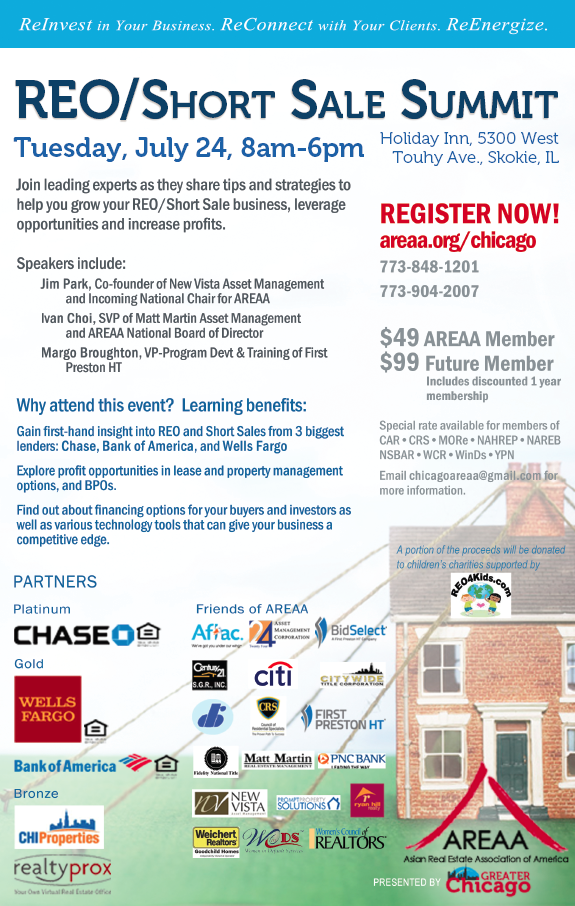By: Nesa Grider

Start a Bidding War
Instinctively, I know those of us listing and selling properties will benefit from the encouraging news in the media about the recovering housing market because it reassures potential buyers that the time to buy is now. But as Oprah Winfrey often asks her guests: What do you know for sure? What I know for sure is that converting a recovering market into individual home sales has far more to do with how we market ourselves as real estate professionals and the creative ways we generate positive attention to our listings, than it does with good news in the media. Consider these techniques to generate viable offers and start a bidding war on your properties:
Develop a Solid Market Strategy for Each Property: Identify the target market for each property and create a plan for catching the eye of the most likely buyer. If it is an investor, include in the marketing information the capitalization rate, average market rents and vacancy rates in the area, so the investor can quickly determine if it meets their criteria. If owner occupants are the target, determine how to uniquely distinguish the property from others in the market – such as exemplary schools in the area, appliances that can remain with the house or other value-added characteristics that will generate offers.
Capture the Advantages of an Electronic Marketplace: Choosing the best online real estate market for your listings may appear complicated since some 700,000 electronic markets are available for real estate sales. Rather than automatically using one of the industry standards, choose sites that meet these four key criteria: update data daily so buyers know the availability of a property; allow you to brand your listings by placing your photo and contact information in a highly visible location on the property posting; prominently promote “featured” properties; and offer online transaction functionality to communicate in real time with buyers and their agents.
Offer the Convenience of Online Offer Negotiation: The benefits of online transactions in residential real estate sales include accepting, reviewing and negotiating offers in real-time, and producing a best and final within minutes. For the 79 million Gen Y or Millennials that now outnumber the Baby Boomers and represent a growing volume of real estate offers, the electronic marketplace and online offer negotiation are your best options for reaching these buyers to generate offers.
Ramp Up Your Social Media Outreach: Use an electronic marketplace that integrates a “one stop” social media dashboard so you can manage Facebook, Twitter, YouTube and other e-communications from one convenient place – the outreach you achieve through consistent social media communications has the potential to increase your business opportunities.
Promote Assets Internationally: I also “know for sure” that while real estate is local, the market is now global. NAR’s recent report on international sales shows international buyers purchased $82.5 billion in real estate in the U.S. over the past 12 months.1 Home purchases by the Canadians, Chinese, Mexicans, British and Indians for properties in New York, California and Florida top the list. With more international buyers viewing the U.S. as a safe place for real estate investments, you may find that properties in proximity to manufacturing and other business investments, university campuses and recreational sites appeal to these buyers. What’s the best way to reach international buyers? Start by placing your listings on a global electronic marketplace that allows you to feature homes for minimal fees and provides an option for online offer negotiation and ready use of social media. Since turnkey solutions are particularly appealing to international buyers, make certain to have a rental program to recommend.
Market the Advantages of Urban Living: Recent data from the Census shows many U.S. cities are growing faster than their suburbs, reversing a decade’s old trend. In fact, from July 2011-2012, in 27 of the country’s 51 largest metropolitan areas, city centers grew faster than surrounding suburbs, compared to only five metro areas during the previous 10 years.2 Increased safety in cities, convenient access to public transportation and revitalized entertainment and retail areas are appealing to commuters weary of high gas prices and long commutes.
Attitudes about the U.S. housing market continue to improve. Fannie Mae’s June survey showed that 73% of Americans surveyed believe it is a good time to buy a home, with 69% of respondents saying they will buy.3 Rising rental costs and low mortgage rates have become a significant incentive for potential homeowners to purchase and investors to expand their portfolios. These market trends will not automatically generate offers for properties. But, if you implement a strategic marketing plan, skillfully use the right electronic marketplace and social media communications, you may start a bidding war.
To view the original article, please visit RISMedia.
Nesa Grider is Executive Vice President of First Preston HT, a licensed real estate broker in Texas and Oklahoma and Six Sigma Black Belt. Ms. Grider is a client of BidSelect.com. For more information visit http://bidselect.com.
Sources:
- National Association of Realtors study as reported in the Wall Street Journal “Overseas buyers seek shelter in U.S. real estate” June 29, 2012
- Wall Street Journal article “Cities Outpace Suburbs in Growth” by Conor Dougherty and Robbie Whelan, June 28, 2012
- Fannie Mae study quoted in Wall Street Journal article “Fannie Mae: Optimism on Homeownership Improves in June,” July 9, 2012
 The opening ceremony of the Olympics. Your favorite Fourth of July fireworks display. The face of a child with a new toy. These are magical experiences all made memorable because someone took the time to pay attention to the details.
The opening ceremony of the Olympics. Your favorite Fourth of July fireworks display. The face of a child with a new toy. These are magical experiences all made memorable because someone took the time to pay attention to the details. 








